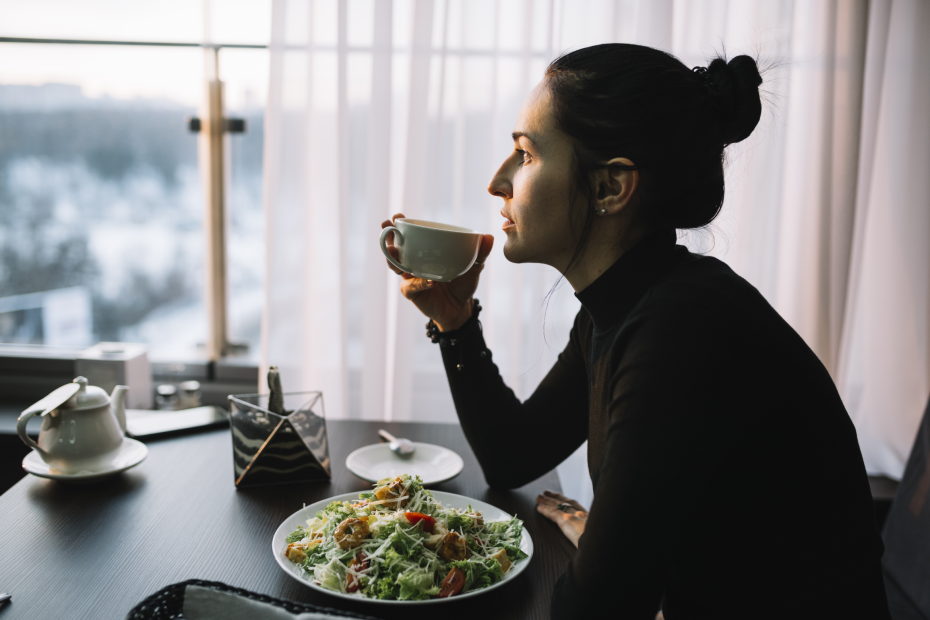The diner scene from the 1989 film When Harry Met Sally, which contained the now-famous line “I’ll have what she’s having.”
Credit: Columbia Pictures
When you’re trying to eat healthy, eating out can seem like a mine field. It can feel like one false step will blow up your whole healthy-eating effort! But it doesn’t have to be that way.
By following a few tips, you can defuse potential dietary bombs and have a healthy and enjoyable dining-out experience.
Before you go
• Check the menu online ahead of time, if possible, to find healthy options and avoid unpleasant surprises (“Oh, the restaurant only serves fried food?”).
Beverage
• Get water or a low-calorie/no-calorie beverage such as unsweet tea. Avoid cocktails, wine, and beer as well as sugary drinks such as fruit juice or cola. If you must have cola, choose diet or don’t get unlimited refills.
Appetizer/Salad
• Avoid getting an appetizer unless it is healthier (like raw veggies with hummus—but remember beans are not low-calorie) and will help you eat less of the entrée.
• If there is a buffet, order off the menu instead of using the buffet. Or use the buffet only to get a salad with lots of vegetables.
• When getting any type of salad, get the dressing on the side. Choose an oil-and-vinegar type dressing instead of a creamy dressing. Either spread the dressing on the salad lightly or dip your fork in the dressing and then into the salad before each forkful. Avoid less-healthy toppings like bacon, croutons, and candied or regular nuts
• If getting soup, choose a broth-based soup with vegetables in it, rather than a cream-based soup.
Main Dish/Entrée
• Order an appetizer or side dish for your entrée. (It will be less food and could potentially be a healthier item, such as fresh—not fried—spring rolls with tofu.)
• Choose an entrée that does not come with heavy sauces (like Alfredo or bechamel) or gravies—these can contain lots of fat and salt.
• Choose a healthy vegetarian or vegan option, such as a butternut squash curry, black bean chili, or chickpea stew.
• Choose lean meats such as chicken or fish. Remove (do not eat) the skin of baked or rotisserie chicken. If you order beef, pick a leaner cut, such as sirloin tip, top round, or bottom round. Avoid t-bone, ribeye, porterhouse. Eat only 3-4 ounces of beef—about the size of a deck of cards (many restaurant steaks are 6-12 ounces).
• Choose dishes that are grilled, steamed, baked, or broiled instead of fried or sautéed.
• If you want to order a pizza, choose a thin crust, get only veggie toppings (no meat), and ask for just half the normal amount of cheese.
• If portion sizes are large, split the entrée with one of your companions or put half aside and plan to take it home.
Pro Tip: Eat slowly and put down your fork between bites. You will feel full sooner this way, and end up eating less.
Sides
• Choose a vegetable, grilled, steamed, or baked.
• Choose a salad (see Appetizer/Salad recommendations, above) or fruit instead of potatoes or rice.
• Opt for two vegetable sides instead of a veggie and a starch, if you have the choice of more than one side. (A side salad and grilled asparagus, for example.)
• Choose a baked potato instead of fries. Apply toppings (butter, sour cream) sparingly.
Dessert
• Avoid dessert when possible.
• Choose fruit over pastries, cake, or ice cream.
• Split a decadent dessert with your dining companions so you only have a few bites.
Some Other Tips That May Be Helpful
• Skip the bread basket at the table or eat only one small piece.
• If you really want fries, share them with your dining companions.
• Choose low-sodium soy sauce.
• Choose whole-grain bread for sandwiches.
• Use ketchup, mustard, pickles, salsa, olive oil, or hot sauce instead of mayonnaise.
Remember, you can have your cake and eat it, too—by sharing it with your dining companions!
A Closer Look: Regular Fries vs Sweet Potato Fries
You may think sweet potato fries are a healthier alternative to regular fries; after all, raw sweet potatoes contain more potassium and vitamin A than white potatoes. Unfortunately, once you deep fry the two types, they are very much the same, says Houston Methodist Hospital Clinical Dietician Emma Willingham: very unhealthy. That’s because frying in oil increases the amount of carbs, calories, and fat. And, if the deep fryer oil is used over and over, as it can be in restaurant deep fryers, trans fats can also be produced.
The Bottom Line
Eating healthy doesn’t mean you can never dine out again. There are a number of ways you can boost the healthiness of restaurant meals and still feel like you had a satisfying experience.
Sources:
Cleveland Clinic
Houston Methodist Hospital (regular vs sweet potato fries)
Mayo Clinic (cuts of beef)
National Heart, Lung, and Blood Institute
Rutgers University NJAES
 share
share



